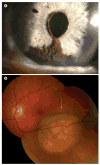Emerging insights into the molecular pathogenesis of uveal melanoma
- PMID: 18922120
- PMCID: PMC2577578
- DOI: 10.2217/14796694.4.5.629
Emerging insights into the molecular pathogenesis of uveal melanoma
Abstract
Uveal melanoma is the most common primary cancer of the eye, and often results not only in vision loss, but also in metastatic death in up to half of patients. For many years, the details of the molecular pathogenesis of uveal melanoma remained elusive. In the past decade, however, many of these details have emerged to reveal a fascinating and complex story of how the primary tumor evolves and progresses. Early events that disrupt cell cycle and apoptotic control lead to malignant transformation and proliferation of uveal melanocytes. Later, the growing tumor encounters a critical bifurcation point, where it progresses along one of two genetic pathways with very distinct genetic signatures (monosomy 3 vs 6p gain) and metastatic propensity. Late genetic events are characterized by increasing aneuploidy, most of which is nonspecific. However, specific chromosomal alterations, such as loss of chromosome 8p, can hasten the onset of metastasis in susceptible tumors. Taken together, this pathogenetic scheme can be used to construct a molecularly based and prognostically relevant classification of uveal melanomas that can be used clinically for personalized patient management.
Figures



References
-
- Inskip PD. Frequent radiation exposures and frequency-dependent effects: the eyes have it. Epidemiology. 2001;12(1):1–4. - PubMed
-
- Singh AD, Bergman L, Seregard S. Uveal melanoma: epidemiologic aspects. Ophthalmol Clin North Am. 2005;18(1):75–84. Overview of several clinical, histopathologic, cytologic, cytogenetic and molecular genetic factors that are related to the prognosis of uveal melanoma. - PubMed
-
- Harbour JW. Clinical overview of uveal melanoma: introduction to tumors of the eye. In: Albert DM, Polans A, editors. Ocular Oncology. Marcel Dekker; NY, USA: 2003. pp. 1–18.
-
- Bedikian AY, Legha SS, Mavligit G, et al. Treatment of uveal melanoma metastatic to the liver: a review of the M. D. Anderson Cancer Center experience and prognostic factors. Cancer. 1995;76(9):1665–1670. - PubMed
Publication types
MeSH terms
Grants and funding
LinkOut - more resources
Full Text Sources
Other Literature Sources
Medical
Miscellaneous
